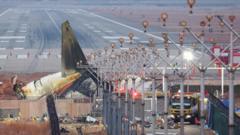In the wake of South Korea's worst aviation disaster, which claimed the lives of 179 people, the focus has turned to a concrete wall located near the runway of Muan International Airport. Footage showed the Jeju Air plane departing from the runway before colliding with this wall, resulting in a devastating fire. Aviation specialists are now questioning the appropriateness of this wall, positioned about 250 meters from the runway's end, and whether its presence exacerbated the crash's severity.
David Learmount, an expert in air safety, indicated that if the wall had not been there, the aircraft might have come to a complete stop with all of its occupants surviving. The plane reportedly struck a bird, prompting the pilot to abort the landing. As the aircraft touched down on the 2,800-meter runway without deploying its landing gear, it managed a controlled landing, which Learmount described as a "flapless/gearless touchdown."
However, the crash's fatality statistics highlight a grim truth: the collision with the wall—termed an "obstruction"—played a crucial role in the outcome. Christian Beckert, a pilot currently flying with Lufthansa, revealed to Reuters the rarity of such solid structures at runway termini, underscoring the unusual design of this particular wall, which is utilized to house a navigation system essential for aircraft landings.
The South Korean transport ministry acknowledged that other domestic and international airports employ similar navigation aids, suggesting a broader issue regarding airport safety standards. The ministry's statement implied they would evaluate whether lighter materials could have been used to construct the wall, reducing its impact risk.
Chris Kingswood, a seasoned pilot, emphasized the critical need for obstructions close to runways to be "frangible," meaning they should easily break upon contact with an aircraft. He questioned whether the airport met industry standards and warned of the potential hazards posed by rigid structures in proximity to runways.
The implications of the investigation extend beyond the wall itself. Sally Gethin, an aviation analyst, raised concerns about whether the pilot was adequately informed of the wall's existence under the new approach directions provided by air traffic control during the landing attempt. As investigations continue, questions linger regarding pilot awareness, air traffic control directives, and the setting of safety protocols at airports that could prevent future tragedies.
The full scope of the investigation, including data from the aircraft's black boxes, may yield essential insights into the tragic crash, contributing to a better understanding of safety measures that could avoid similar fates in the future.
David Learmount, an expert in air safety, indicated that if the wall had not been there, the aircraft might have come to a complete stop with all of its occupants surviving. The plane reportedly struck a bird, prompting the pilot to abort the landing. As the aircraft touched down on the 2,800-meter runway without deploying its landing gear, it managed a controlled landing, which Learmount described as a "flapless/gearless touchdown."
However, the crash's fatality statistics highlight a grim truth: the collision with the wall—termed an "obstruction"—played a crucial role in the outcome. Christian Beckert, a pilot currently flying with Lufthansa, revealed to Reuters the rarity of such solid structures at runway termini, underscoring the unusual design of this particular wall, which is utilized to house a navigation system essential for aircraft landings.
The South Korean transport ministry acknowledged that other domestic and international airports employ similar navigation aids, suggesting a broader issue regarding airport safety standards. The ministry's statement implied they would evaluate whether lighter materials could have been used to construct the wall, reducing its impact risk.
Chris Kingswood, a seasoned pilot, emphasized the critical need for obstructions close to runways to be "frangible," meaning they should easily break upon contact with an aircraft. He questioned whether the airport met industry standards and warned of the potential hazards posed by rigid structures in proximity to runways.
The implications of the investigation extend beyond the wall itself. Sally Gethin, an aviation analyst, raised concerns about whether the pilot was adequately informed of the wall's existence under the new approach directions provided by air traffic control during the landing attempt. As investigations continue, questions linger regarding pilot awareness, air traffic control directives, and the setting of safety protocols at airports that could prevent future tragedies.
The full scope of the investigation, including data from the aircraft's black boxes, may yield essential insights into the tragic crash, contributing to a better understanding of safety measures that could avoid similar fates in the future.





















